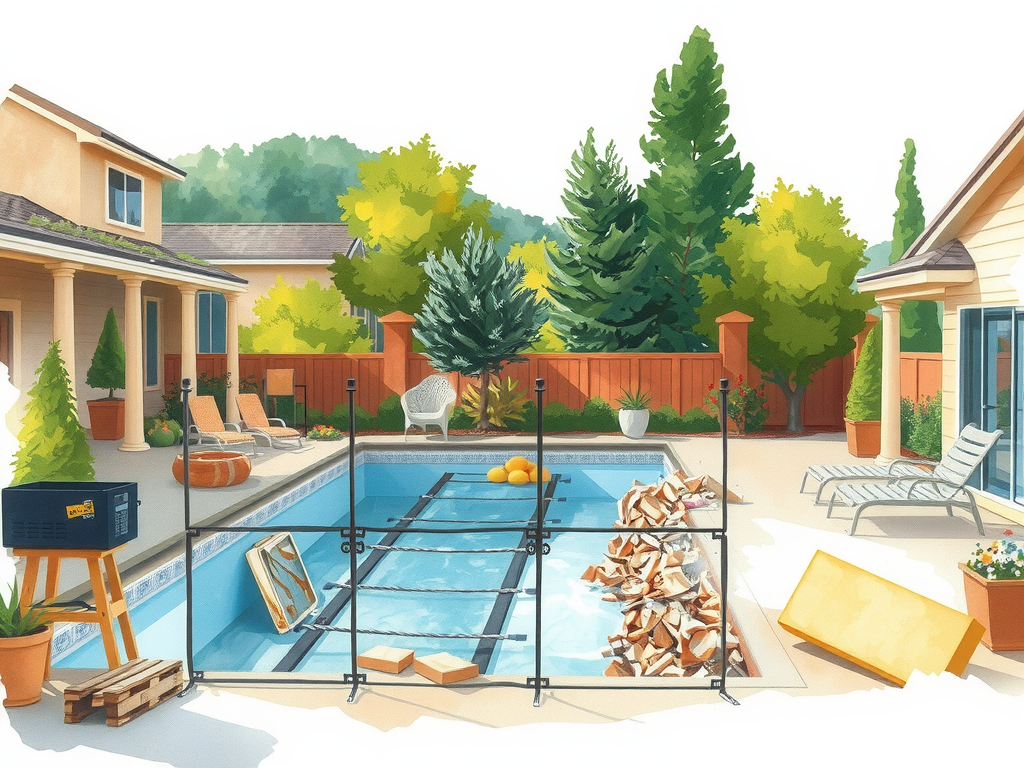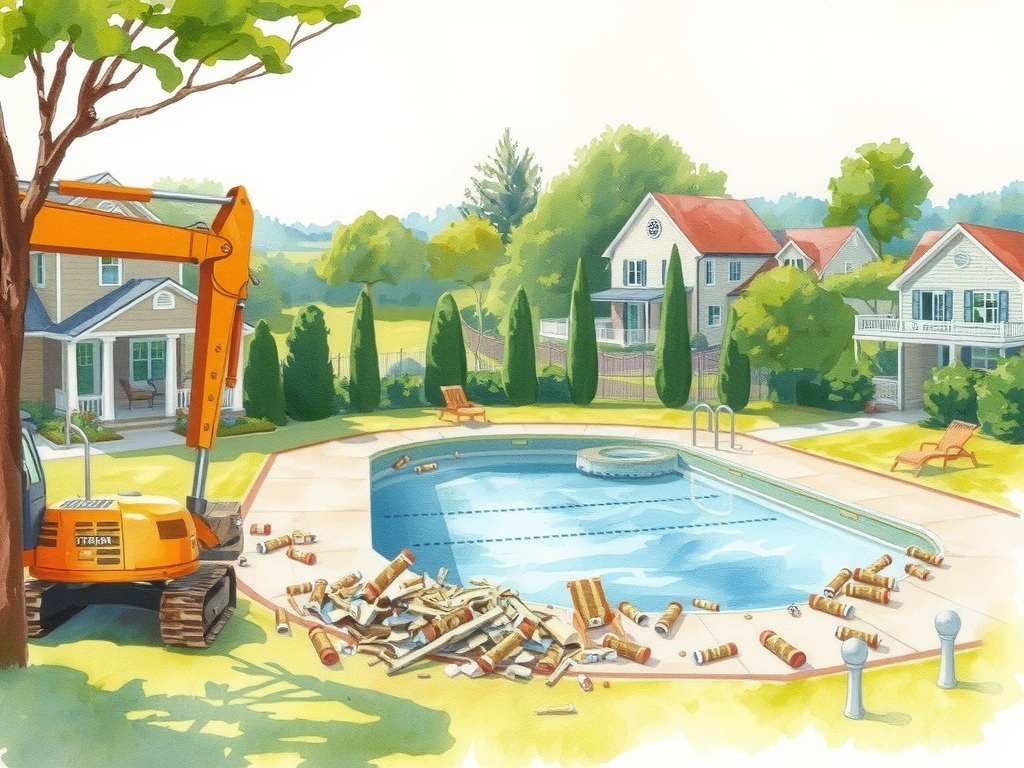
Swimming pool demolition involves the complex process of removing a pool from a property, addressing safety hazards, or facilitating new landscaping projects. This task is crucial for many homeowners when a pool is no longer viable, poses potential risks, or hinders the planned yardspace enhancement.
Two primary types exist: partial removal, which involves pool cavity filling, and complete removal, encompassing total structural excavation.
Choosing the right demolition approach can lead to significant benefits, including reduced maintenance costs, improved property usability, and increased property value.
For those planning future backyard conversion projects, understanding this process can greatly aid in making informed decisions.
Click here to learn more about: ntxpoolremoval.com
Inground Pool Deconstruction Steps
Initial Procedures
Inground pool deconstruction begins with draining the pool, a step that requires careful planning to ensure water drainage compliance. This crucial first step must be responsibly managed to prevent environmental repercussions.
A site-specific removal plan is essential to detail the pool’s location and its proximity to existing structures.
Demolition Techniques and Safety
- The next phase involves vinyl liner removal or breaking down materials like concrete or fiberglass using pneumatic tools or excavators.
- Simplify the process by opting for heavy equipment operation during low-activity periods to minimize neighborhood disruption.
- Implement safety protocols by securing the demolition site with fencing and ensuring workers use appropriate gear.
Eco-Friendly Debris Disposal
Managing waste through ecofriendly debris clearance is critical. Ensure all materials are recycled or disposed of according to environmental regulations. An eco-friendly disposal maximizes environmental protection and maintains water drainage compliance.
Post-Demolition Opportunities
Yard-space enhancement following demolition offers various opportunities for area transformation. The cleared land can be converted into gardens, patios, or outdoor living spaces. By adhering to landscaping improvement strategies, homeowners can significantly enhance property aesthetics and usability, with soil stabilization ensuring the land remains viable for future construction or planting.

How to Conduct Pool Emptying Procedures
Inground pool deconstruction requires meticulous planning, especially during the pool emptying procedures. Efficient disposal of water is pivotal to adhere to water drainage compliance and avoid penalties.
Start by deploying a multi-stage pump that incrementally lowers the water level, ensuring no rapid release harms the environment.
Opt for redirecting the water to yard-space enhancement projects like garden irrigation, which effectively utilizes resources and supports foliage restoration.
Emphasize compliance with environmental standards by directing residual water into pre-approved local drains.
Prepare essential tools like submersible pumps, ensuring that each pool hazard elimination step aligns with soil stabilization goals. The connection between successful water management and structural excavation sets a firm foundation for subsequent backyard renovation phases.
Anticipate transitions to pool removal machinery operations, ensuring all steps up to this point facilitate an efficient shift towards demolition site clearance.
Understanding Structural Excavation Basics
Structural excavation forms a crucial part of the pool demolition process. Proper selection of tools, such as excavators and pneumatic tools, is essential to avoid delays and ensure project safety protocols.
Choosing the right machinery aligns with structural goals, enhancing productivity and minimizing risk.
Avoiding Common Mistakes
Yard-space enhancement projects benefit from strategic planning, yet significant missteps can arise.
One common mistake during pool removal involves neglecting project permits, which is cost estimation critical.
Failing to secure proper documentation can halt operations and incur fines, impacting the project timeline. Emphasize regular safety inspections to maintain operations in line with waste management standards.
Foundation removal must be conducted with precision, anchored in sound gravel standards to ensure stability and resilience in future construction redevelopment efforts.
Attention to detail in aligning with permit acquisition requirements, structural integrity, and maintenance abatement plans ensures the area is ready for landscaping improvement or other area transformation projects.
Consistent focus on goal alignment guides each step of the process effectively.
Key Points on Pool Deconstruction and Excavation
- Effective pool emptying requires multi-stage pumps to prevent environmental harm.
- Redirecting pool water to garden irrigation supports foliage restoration.
- Proper tool selection, like submersible pumps and excavators, is crucial for soil stabilization and structural excavation.
- Neglecting project permits can lead to fines and project delays.
Enhancing Yard Space Through Renovation
Inground pool deconstruction can significantly contribute to yard-space enhancement, presenting new opportunities for property utilization. Pool removal can recover up to 400 square feet of land, turning previously confined spaces into functional areas for outdoor activities.
Sustainable landscaping post-renovation is an excellent way to transform the area into an eco-friendly oasis.
Incorporating native plant gardens or rain gardens not only reduces water consumption but also fosters biodiversity.
Property owners interested in a modern touch might consider converting the space into a patio or an outdoor living area for improved utility and aesthetic appeal. Pool removal, through effective landscaping improvement, enhances property value while providing a more functional outdoor environment.
Safely Eliminating Pool Hazards
Structural excavation of pools requires strict adherence to safety measures to prevent environmental and structural hazards.
Proper pool emptying procedures are essential for preventing soil erosion and potential contamination. Safety protocols mandate a thorough pre-demolition checklist:
- Secure project permits to comply with local regulations.
- Conduct an integrity assessment to identify underground utilities.
- Ensure water drainage compliance to mitigate environmental risks.
- Utilize licensed contractors for professional oversight.
By following these guidelines, pool hazard elimination can be managed safely, paving the way for safer and better yard utilization.
Yard Renovation and Pool Removal
- Pool removal can reclaim up to 400 square feet of yard space.
- Sustainable landscaping can create an eco-friendly oasis.
- Converting pool spaces into patios enhances property utility.
- Proper pool removal increases property value and safety.
Techniques For Removing Vinyl Liners
Inground pool deconstruction begins with the precise removal of vinyl liners, an essential aspect of the process. Pool emptying procedures include responsibly draining the pool to comply with environmental standards.
To ensure an effective method, carefully cut the liner into manageable sections.
This approach facilitates a controlled vinyl liner removal, minimizing potential damage to surrounding yard-space or landscaping.
Utilize techniques such as:
- Ensure precise cuts to prevent pool hazard elimination
- Gradual extraction to protect nearby structures
By adhering to safety protocols and environmental guidelines, one can achieve a seamless transition to the subsequent phases of pool removal, which involves using the appropriate machinery for efficient execution.
Essential Machinery For Pool Removal
Structure elimination requires specialized machinery to ensure efficiency during the demolition process.
Excavators serve as a cornerstone of structural excavation due to their capability to dig and displace large volumes of materials.
These machines play a pivotal role in streamlining the demolition timeline.
Pneumatic hammers are also fundamental; they efficiently break down concrete components, ensuring smooth grading and debris clearance. Incorporating these tools reduces labor costs and enhances the overall safety of the operation.
By leveraging these heavy equipment operation essentials, one can facilitate a successful pool removal, paving the way for construction site preparation and subsequent yardspace enhancement. Transitioning from vinyl liner removal to machine utilization marks a significant step in ensuring site-specific removal success.
| Vinyl Liner Removal Techniques | Essential Machinery for Demolition |
|---|---|
| Precise cuts prevent hazards | Excavators for material displacement |
| Gradual extraction protects structures | Pneumatic hammers for concrete breakdown |
| Compliance with environmental standards | Reduces labor costs and enhances safety |
Planning A Backyard Renovation
Backyard renovation projects can significantly enhance your outdoor space. Yard-space enhancement begins with establishing a well-defined timeline, ensuring seamless integration of new landscape features.
An initial assessment of your current landscape helps identify areas for improvement.
This process involves setting a renovation plan that addresses critical phases like structural excavation or feature integration.
Be prepared for possible delays due to weather or permit acquisition processes. Structuring a phased approach ensures smoother progression, minimizing disruptions.
Consulting with landscapers is beneficial to balance design aspirations with practical implementations, optimizing the final outcome.
Enhancing Your Outdoor Space
Increasing yard usability through backyard renovation often involves pool removal. Pool emptying procedures start the transformation, done responsibly to prevent environmental damage.
From inground pool deconstruction to vinyl liner removal, eliminating a pool hazard involves multiple steps.
For complete removal, heavy equipment operation might be required for concrete slab removal or shell deconstruction.
Considerations of gravel standards and soil stabilization are pertinent for the pool cavity filling process. Certified contractors ensure compliance with safety protocols and water drainage compliance.
Transforming Your Landscape
After the pool removal, the property can undergo landscaping improvement.
Foliage restoration aligns with your renovation plan. Various approaches, such as component recycling or repurposing materials, contribute to ecofriendly disposal.
The footprint reduction from structure elimination enhances the space for new landscaping projects.
Debris logistics ensure waste management aligns with recycling regulations.
Successful renovation plans account for depth calculation and safety enhancement, reducing hazards while maximizing available area transformation.
Project Considerations and Compliance
Before starting any construction redevelopment project, ensure all project permits are secured. Conducting an integrity assessment helps in understanding the site’s condition.
Employing demolition techniques like pneumatic tools or jackhammers addresses structural challenges. Proper retention of existing elements or foundation removal may be necessary based on your project’s needs.
Engaging in a safety inspection ensures all practices comply with safety and rehabilitation standards.
Backyard Renovation
- Backyard renovation projects can significantly enhance your outdoor space.
- Establishing a well-defined timeline ensures seamless integration of new landscape features.
- Pool removal involves multiple steps, including pool emptying procedures and concrete slab removal.
- Consulting with landscapers helps balance design aspirations with practical implementations.
Pool Demolition Contractors Transform Denton And DFW Spaces
Pool Demolition Services Simplified
